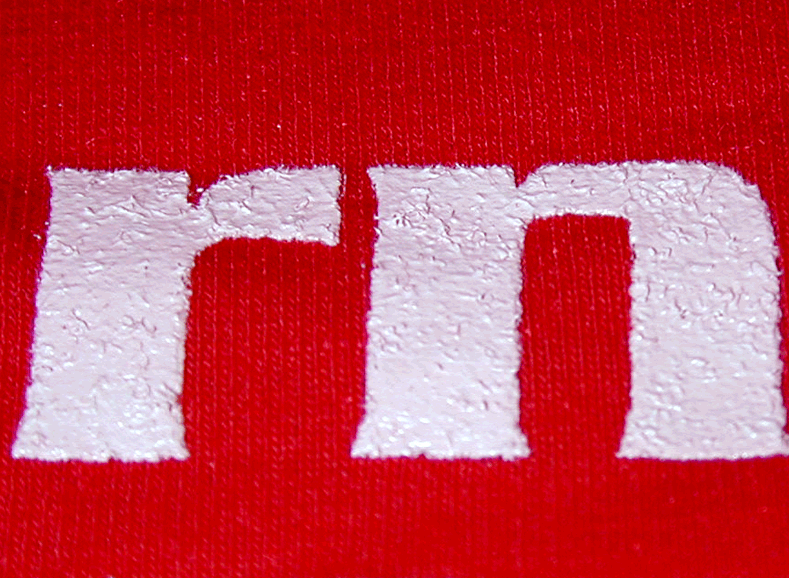Fibrillation Issues?
July 10, 2010
What exactly is fibrillation all about? No, we are not talking about cardiac arrhythmia or anything to do with the heart here, but about the fibers on your fabric or T-shirt. Some printers notice their print taking on a fuzzy or faded look and notice that the fibers of their shirt is showing through the print. This problem often occurs immediately after printing or after the shirt has been washed a few times. Here is Ed Branigan with some insight on this topic:
“Fibrillation is a pain. Sometimes it’s an easy pain to get rid of, but at other times it turns into a nightmare. Most printers, when they encounter fibrillation issues, assume at first that it’s the ink. It’s not opaque enough, they think, I can see the shirt color showing through. The most obvious answer is to flash, then print again. But the shirt color still seems to be showing through. And it looks hairy and weird. This is the point were I get calls:
“Something’s up with your ink. It’s not opaque enough. I’ve printed and flashed and printed 2 or 3 times and I can still see some shirt color and it looks all hairy and weird. “
The type of ink being used may be an issue but it’s not the cause of the problem. Fibrillation occurs on mostly jersey type fabrics that have been brushed on the outside to give them a softer feel. The brushing causes abrasions along the fibers with the result being lots of tiny follicles standing or lying on the very outside layer of the garment fabric.
What happens during printing is that after you have done your print stroke and are lifting your screen up, these mini fibers are pulled up with it. They got pushed down when you were printing and got ink on one side. When you pulled your screen up, the side that doesn’t have ink on it now becomes visible.
It’s kind of an optical illusion: You are seeing shirt color but it’s not from the actual body of the shirt. This part has ink coverage. What you are seeing is the bottom half of these miniature fibers that don’t and it’s giving you the impression that something’s up with the ink.

There are several approaches to alleviating the problem when using plastisol inks, one of which involves the ink itself. If the fibrillation is particularly invasive, then ink that has a lower viscosity will exacerbate the problem. What happens with ink that’s a little thinner is that in some cases, the ink film is not thick enough and the fiber has enough weight to it that it pops back up when you lift the screen.
This sounds counterintuitive, especially when you are standing in front of the problem for the first time. All you have to do is wet the fibers with ink and they should matte down but the opposite is the case.
The first thing to do to combat fibrillation is to use a thicker ink or thicken up the one that you’ve got. If the ink has a low viscosity and a good deposit is laid down, this can go a long way to keeping those fibers down where they belong. Once the ink is cured, they will stay down.
A second approach is using what is called a matte-down screen. This involves using a blank screen which has been coated with emulsion and exposed to harden it.
Take this screen and place it in the cool-down station, after your flash. Once you have printed and flashed the offending fabric, use a clear, a gel or an ink in the blank screen and “print” it. Use a hard squeegee and a lot of pressure to push the fibers back down, giving you a smoother surface to print the second white on. This should give you an overall smoother and more opaque print.
All of the above works well for plastisol inks in most instances. For water-based inks it’s a different matter. The printed image can look just fine after it’s been cured but before you congratulate yourself you better wash it first. In some cases the viscosity of a water-based ink is so low that it is wet enough to keep the fibers down. But during the wash cycle these fibers are released and because they have no ink on their bottom halves like their plastisol counterparts, they give the appearance of shirt color showing through.
An approach that sometimes works is to press the shirt with a heat transfer machine after curing. This can help keep the fibers down during the wash.
As with discharge and dye migration, with fibrillation a large part of the issue lies with the fabric. If it’s cheaply made, it’s not going to behave as well as one that isn’t and besides, it would be both cost prohibitive and inefficient for ink manufacturers to make a different ink for every problem on every substrate. They try to make a smaller group of products that can be applied across a broad range of fabric material.
There’s no easy way to deal with fibrillation. It involves practice, a lot of patience and sometimes a little bit of luck.”
For more on International Coatings products, visit our website at www.iccink.com.


